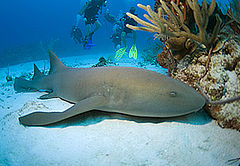Ginglymostomatidae
Ginglymostomatidae – rodzina kosmopolitycznych, morskich ryb chrzęstnoszkieletowych z rzędu dywanokształtnych (Orectolobiformes).
| Ginglymostomatidae[1] | |||
| Gill, 1862[2] | |||
 Przedstawiciel rodziny – Ginglymostoma cirratum | |||
| Systematyka | |||
| Domena | |||
|---|---|---|---|
| Królestwo | |||
| Podtyp | |||
| Gromada | |||
| Podgromada | |||
| Infragromada | |||
| (bez rangi) | Selachii | ||
| Nadrząd | |||
| Rząd | |||
| Rodzina |
Ginglymostomatidae | ||
| Synonimy | |||
|
| |||
| Rodzaje | |||
| |||
Zasięg występowania edytuj
Wody oceaniczne strefy tropikalnej i subtropikalnej zachodniego Oceanu Atlantyckiego i wschodniego Oceanu Spokojnego.
Cechy charakterystyczne edytuj
Dwie płetwy grzbietowe bez kolców, płetwa odbytowa obecna. Otwór gębowy z wąsikami. Ciało osiąga długość od 75 cm do 4,3 m. Jajożyworodne. Łagodne rekiny, niesprowokowane nie stanowią zagrożenia dla człowieka.
Klasyfikacja edytuj
Rodzaje zaliczane do tej rodziny[6]:
- Ginglymostoma Müller & Henle, 1837
- Nebrius Rüppell, 1837 – jedynym przedstawicielem jest Nebrius ferrugineus (Lesson, 1831)
- Pseudoginglymostoma Dingerkus, 1986 – jedynym przedstawicielem jest Pseudoginglymostoma brevicaudatum (Günther, 1867)
Zobacz też edytuj
Uwagi edytuj
- ↑ Typ nomenklatoryczny: Nebrius Rüppell, 1837; młodszy homonim Nebriini Laporte, 1834 (Coleoptera).
- ↑ Typ nomenklatoryczny: Nebrodes Garman, 1937 (= Nebrius Rüppell, 1837).
- ↑ Typ nomenklatoryczny: Pseudoginglymostoma Dingerkus, 1986.
Przypisy edytuj
- ↑ Ginglymostomatidae, [w:] Integrated Taxonomic Information System (ang.).
- ↑ T.N. Gill. Analytical synopsis of the order of Squali; and revision of the nomenclature of the genera. „Annals of the Lyceum of Natural History of New York”. 7, s. 393, 406, 1862. (ang.).
- ↑ H.F. Fowler. Descriptions of new fishes obtained 1907 to 1910, chiefly in the Philippine Islands and adjacent seas. „Proceedings of the Academy of Natural Sciences of Philadelphia”. 85, s. 238, 1934. JSTOR: 4064176. (ang.).
- ↑ H.F. Fowler. Errata: descriptions of new fishes obtained 1907 to 1910 in the Philippine Islands and adjacent seas. „Proceedings of the Academy of Natural Sciences of Philadelphia”. 86, s. 163, 1934. JSTOR: 4064148. (ang.).
- ↑ J. Herman & H. van Waes. Observations concerning the evolution and the parasystematics of all the living and fossil Chlamydoselachiformes, Squatiniformes, Orectolobiformes, and Pristiophoriformes, based on both biological and odontological data. Suggestion of a possible origin of the order Pristiophoriformes, of the order Ganopristiformes and a global synthesis of the previous systematics proposals. „Géominpal Belgica (découvertes géologiques, minéralogiques et paléontologiques en Belgique)”. 6, s. 118, 2014. (ang.).
- ↑ Ron Fricke, William Neil Eschmeyer, Richard Van der Laan (red.), SEARCH, [w:] Eschmeyer's Catalog of Fishes, California Academy of Sciences, 2024 [dostęp 2024-03-05] (ang.).
Bibliografia edytuj
- Froese, R. & D. Pauly: Family Ginglymostomatidae - Nurse sharks. FishBase. World Wide Web electronic publication. www.fishbase.org, 2008. [dostęp 2009-02-02]. (ang.).
- Włodzimierz Załachowski: Ryby. Warszawa: Wydawnictwo Naukowe PWN, 1997. ISBN 83-01-12286-2.